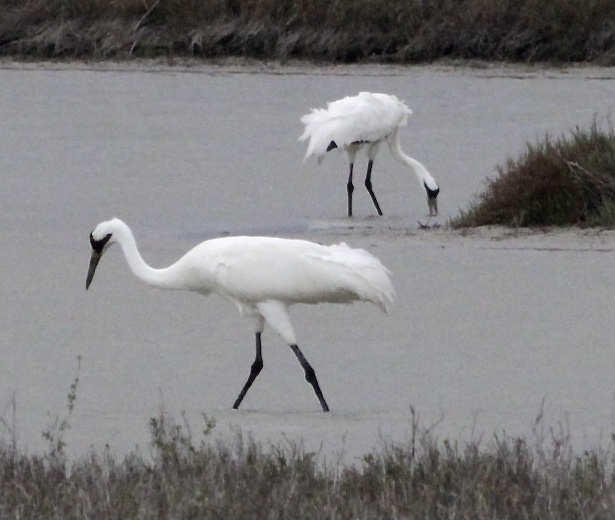This week in birds - #537
A roundup of the week's news of birds and the environment:
A pair of Whooping Cranes search for a meal in shallow waters at the edge of the Gulf of Mexico.*~*~*~*
It's that time of year again! Time for the Great Backyard Bird Count, my favorite citizen science project and one in which we all can participate.
*~*~*~*
This is Flaco, a Eurasian Eagle-owl. He escaped from the Central Park Zoo a few days ago after someone vandalized the enclosure where he lived. As of today, he is still on the loose.
*~*~*~*
The Colorado River is drying up. Is it even possible at this point to avert this disaster?
*~*~*~*
P-22 at home on his range.
Los Angelenos, and many of the rest of us, this week mourned the death and celebrated the life of one of the city's most famous inhabitants, the mountain lion known as P-22 who was euthanized after being hit by a car.
*~*~*~*
Near Los Angeles, the poppies that cover its hillsides will soon be in bloom and that creates problems for the towns that have to deal with all the tourists rushing to see what is expected to be a "super bloom." Some roads and trails will be closed to discourage tourists.
*~*~*~*
Lead poisoning is still a danger to California Condors, one of the world's most endangered birds.
*~*~*~*
Elsewhere in California, bird lovers battled with a utility company that wanted to cut down a pine tree. It just happened to be a pine tree where Bald Eagles had nested for years.
*~*~*~*
Scientists can be intrepid in the pursuit of their science. Not even an erupting volcano can discourage them!
*~*~*~*
Many essential insects in East Asia have suffered massive declines in population. Why, and can the trend be reversed?
*~*~*~*
What is it about giant panda cubs? They are certifiably adorable!
*~*~*~*
The Mexican cavefish has adapted to life away from light and most sources of food and still, it manages to survive and even thrive.
*~*~*~*
Acorn Woodpeckers were able to store some 700 pounds of acorns in the chimney of a Santa Rosa, California house.
*~*~*~*
The spotted-tail quoll of Queensland, Australia is facing extinction because of a combination of factors.
*~*~*~*
*~*~*~*
The cane toad is "public enemy number one" in Queensland, Australia and a competition finds plenty of participants that are eager to help rid the place of the invasive amphibians.
*~*~*~*
What color should a bee be? Turns out there is some controversy over the answer to that question.
*~*~*~*
Here are pictures of some of the beautiful birds of Costa Rica.
*~*~*~*
*~*~*~*
Nearly 60 million years ago, there was a giant penguin species that weighed around 350 pounds and lived along the coastline of New Zealand.
*~*~*~*
Sudden, extreme changes in the weather can prove fatal for migrating birds.
*~*~*~*
The discovery of some ancient tools has sparked questions about which hominin species was responsible for the technology that created them.
*~*~*~*
Check out the variety of bird species visiting this backyard Oregon suet feeder.
*~*~*~*
There are many benefits of habitat restoration but one of the main ones is the recovery of bird species dependent on that habitat.
*~*~*~*
The protection of the Great Bear Rainforest of British Columbia has proved to be a triumph of conservation policy.
*~*~*~*
Orca moms seem to prefer sons and that may have some impact on the species' endangered status.
*~*~*~*
Should Endangered Species Act protections be terminated for grizzly bears in the Greater Yellowstone Ecosystem? That is the question being considered by the Fish and Wildlife Service.
*~*~*~*
A new reserve in Chile will protect the largest known colony of Markham's Storm-Petrel, a secretive and little-known seabird.
*~*~*~*
There is significant genetic diversity among corals and some of them have greater resistance to heat than was previously thought.
*~*~*~*
Cockatoos are the veritable Einsteins of birds and are amazingly adept at using tools.
*~*~*~*
There's a new cash crop being grown in Australia's Outback: carbon.
*~*~*~*
Big Sur, California is a ruggedly beautiful area but storms can sometimes cut it off from the rest of the state.
*~*~*~*
Finally, here are some wonderful pictures of baby birds from Audubon's photography awards.




Very informative as always! Thank you, Dorothy!!!
ReplyDeleteThank you for reading and taking the time to comment.
DeleteSo many links that I could comment on, but I'll limit myself to two. (1) I'll bet those acorn woodpeckers were not happy when their private Fort Knox was breached! (2) I have to admit that I sympathize with those towns that are closing the area to the hordes of wildflower seekers. I've seen the damage those people can do when we've had super blooms here in Arizona.
ReplyDeleteI agree with you about the wildflower tourists. It is so easy for them to do damage to the environment in their enthusiasm.
DeleteA group of our naturalists from our chapter went down the coast this week to see the Whooping Cranes on a boat tour. Such amazing birds!
ReplyDeleteI was scolded when we were walking with friends this week and I picked a wildflower. No, I was told, that's against the law. Now I need to look that up!
Thank you, Dorothy, for reminding me about the beginning of the Great Backyard Bird Count.
DeleteYou are welcome. Happy counting!
Deleteif I ever need to be cheered up, I definitely watch YouTube videos of baby pandas being mischivious. Turns my whole day around.
ReplyDeleteIt's hard to imagine anything cuter than baby pandas!
Delete